With low- and middle-income residents shut out of home ownership in much of the North Bay, self help housing development is one way to open more doors.
We probably all know someone who works 40 hours a week at a stable job but can’t seem to do more than pay the bills each month. Maybe he or she grew up here, or is raising a family here, and wants to stay in the place where they’ve begun contributing to the community. Maybe he or she dreams of owning a stable home, but Bay Area home prices and their own limited salary seem destined to keep them a renter forever. What if there was something that could level the playing field?
Housing advocates have worked for decades to bring more people into responsible homeownership through self-help housing development. Here we take a look at how it works and why some believe it’s the best way to build community.
What it is, and what it’s not
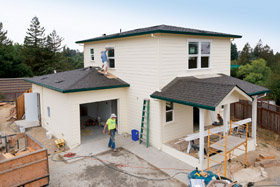 Self-help housing development, also known as mutual self-help or sweat equity development, is a model sometimes used by nonprofit housing developers in which low- to mid-income homebuyers help build their homes (and their neighbors’ homes) in exchange for a reduced down payment or lowered purchase price. The buyers must agree to work anywhere from 20 to 40 hours per week on the job site in addition to their other employment. A combination of local, state and federal subsidies and grants help keep the overall home price low.
Self-help housing development, also known as mutual self-help or sweat equity development, is a model sometimes used by nonprofit housing developers in which low- to mid-income homebuyers help build their homes (and their neighbors’ homes) in exchange for a reduced down payment or lowered purchase price. The buyers must agree to work anywhere from 20 to 40 hours per week on the job site in addition to their other employment. A combination of local, state and federal subsidies and grants help keep the overall home price low.
Self-help housing development does not mean handing over the keys to a new house free of charge. Self-help homes come with a fixed 30- to-35 year, low- to no-interest mortgage. All of the nonprofit developers interviewed for this article have a stringent set of criteria that must be met for homebuyers to qualify.
Self-help housing programs aren’t for people who don’t qualify for homes because of bad credit or job instability. They’re also not appropriate for those who can’t afford a monthly mortgage because they make less than 50 percent of the area’s median annual income.
Habitat for Humanity
Probably the best-known model of self-help housing belongs to Habitat for Humanity (HFH). Made famous by its close ties with former President Jimmy Carter, HFH is an international, Christian housing ministry that builds and renovates houses, parks and other community resources. Each local branch of HFH is known as an affiliate. In the North Bay, HFH of Sonoma County, Solano Napa HFH and HFH Greater San Francisco work closely by sharing ideas and volunteer outreach strategies.
HFH looks at several factors in deciding whether applicants qualify for homeownership. Buyers must be able to pay a 30-year mortgage at an affordable rate, adjusted to be no more than 30 percent of the family’s annual income. This means that neighbors may have different mortgage amounts, even for the same size homes. Families must also earn anywhere from 50 to 80 percent of the area’s median income, have a steady employment history and maintain good credit. A family can be defined any way you choose, as long as the home is being put to full use. The home must be owner-occupied and the space must be needed. A couple can’t qualify for a 3 bed home.
Then, there’s the matter of being willing to partner on the sweat equity portion of the home. Homebuyers commit to working 500 hours on their own homes and the homes of their neighbors. Many of the features of the home are donated, such as the cabinets and flooring, so the homebuyers must be flexible in their expectations.
Each HFH home is sold with a 45- to-55 year deed restriction in place. This means if a homeowner wants to sell the home in the future, HFH has the first right of refusal and will generally buy it back to sell to another qualified buyer. HFH offers the homeowner the full qualified purchase price back, plus three percent qualified annual interest. As they pay no interest and no monetary down payment, this means they’re guaranteed to get back whatever equity they’ve put into the home.
Building these types of housing developments isn’t without challenges, especially here in the Bay Area.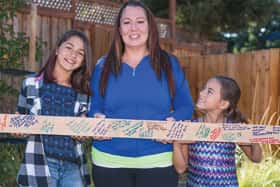 By far the biggest struggle is finding affordable land, so affiliates had to get creative. HFH of Sonoma County is currently in construction on five single-family houses on Woodland Hills Drive in Cotati. The project was made possible through a partnership with the Housing Land Trust of Sonoma County. The land was purchased by (and will continue to be held by) the trust, a nonprofit working to make affordable housing available to more area residents. Homebuyers are buying their houses only from the foundation up, meaning prices are based only on the value of the home and not the land.
By far the biggest struggle is finding affordable land, so affiliates had to get creative. HFH of Sonoma County is currently in construction on five single-family houses on Woodland Hills Drive in Cotati. The project was made possible through a partnership with the Housing Land Trust of Sonoma County. The land was purchased by (and will continue to be held by) the trust, a nonprofit working to make affordable housing available to more area residents. Homebuyers are buying their houses only from the foundation up, meaning prices are based only on the value of the home and not the land.
In Novato, HFH Greater San Francisco is working on the Mt. Burdell Place project, a 10 home development on Fourth Street. The land was purchased from a private home developer, fully entitled, meaning architectural drawings had already been completed and had been cleared through the city. The city of Novato and Marin Community Foundation provided funds for the land purchase. Homeowner selection starts soon and families are expected to move in by spring 2017.
“When we build homes, we take a look at what other houses in the neighborhood look like and what else is being built there,” says Kristine Leja, interim CEO and chief development officer of HFH Greater San Francisco, which covers San Francisco, San Mateo and Marin counties. “This means HFH owners don’t stand out, but really get to be a part of the community in the way they deserve to be.”
Additional funding for HFH comes from a combination of individual and corporate donations, grants and house sponsorships. HFH Sonoma also operates ReStore, a 17,000-square-foot store in Santa Rosa that sells home goods donated by contractors or individuals, including furniture, appliances, cabinets and hardware. The Greater San Francisco affiliate also runs a ReStore in San Carlos.
HFH depends not only on its homeowners and paid construction staff to build its homes, but also on volunteers. HFH volunteers may be corporate groups that come in for a day, retired people who help once a week or contractors who donate time and skills when they can. Tamara Stanley, CEO of HFH of Sonoma County, says even those who don’t think they can help can come greet volunteers or help provide lunch. Volunteers also teach financial education classes for homebuyers to get them off to the best possible start.
The Sonoma affiliate is hosting a special Women’s Build in the week leading up to Mother’s Day. While women are encouraged to volunteer anytime, this day will focus on what women can do when they come together. The San Francisco affiliate hosts a Neighborhood Revitalization program in San Francisco’s Bayview district and in East Palo Alto. Volunteers work with HFH staff to rehabilitate the homes of elderly residents and make improvements to community resources like parks and youth centers.
“Sometimes people get to that point of saying, ‘I know there’s a big crisis in affordable housing here, but what can I do?’” says Stanley. “Well, there’s something you can do.”
Burbank Housing
In Sonoma County, Burbank Housing has been building self-help housing developments for more than 35 years. Burbank is a nonprofit organization trying to increase the supply of affordable homes and rental units for those squeezed out of the current housing situation. The staff is involved in every stage of the self-help development, from securing financing to land planning, construction and finding homebuyers.
Its latest project is Catalina Townhomes, featuring 60 three-bedroom homes located on Dutton Meadow Drive in Santa Rosa. All phases of the project are already under construction, with Phase One expected to be completed in mid- to late 2016 and Phase Two to be completed by late 2016 or early 2017.
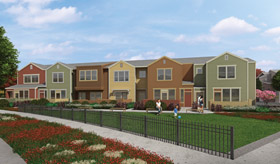 As with HFH, Burbank’s homebuyers must meet a list of criteria to qualify. Buyers must earn less than 80 percent of the area median income, have a minimum FICO score of 640 and have a steady employment history. Homes are deed-restricted to remain in Burbank’s affordable housing pool. Each homebuyer must commit to 30 hours of labor per week to earn their sweat equity, which amounts to the $20,000 down payment. They work alongside Burbank’s construction supervisors, with licensed contractors doing the jobs that require more specialized training. Buyers can have a friend or family member help with up to half of their hours, but the rigors of the program often mean everyone has to pitch in.
As with HFH, Burbank’s homebuyers must meet a list of criteria to qualify. Buyers must earn less than 80 percent of the area median income, have a minimum FICO score of 640 and have a steady employment history. Homes are deed-restricted to remain in Burbank’s affordable housing pool. Each homebuyer must commit to 30 hours of labor per week to earn their sweat equity, which amounts to the $20,000 down payment. They work alongside Burbank’s construction supervisors, with licensed contractors doing the jobs that require more specialized training. Buyers can have a friend or family member help with up to half of their hours, but the rigors of the program often mean everyone has to pitch in.
“Due to the number of hours required on the job site each week, and because households must maintain their incomes to continue to qualify for their home loans, we typically see significant participation by all adult members of the household, regardless of their physical condition or level of construction experience,” says Tom Kuhn, Burbank’s self-help project manager.
The recession may be over, but low-income workers and government agencies are still feeling the worst of its effects.
“While general economic conditions drive the demand for housing and the purchase prices people are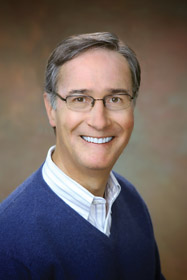 willing to pay, affordable housing is driven primarily by the availability of low cost, long-term governmental financing,” says Chuck Cornell, executive director and CFO of Burbank Housing. “Those government funds have been in very short supply since the recession and the closure of redevelopment agencies.”
willing to pay, affordable housing is driven primarily by the availability of low cost, long-term governmental financing,” says Chuck Cornell, executive director and CFO of Burbank Housing. “Those government funds have been in very short supply since the recession and the closure of redevelopment agencies.”
One indicator of this is a 96-unit apartment project that’s currently stalled in Burbank’s pipeline. The nonprofit has a four-acre parcel in Southwest Santa Rosa all planned and ready for construction, but need far more money than is available from the city of Santa Rosa and other sources to move forward. Meanwhile, most of the properties managed by Burbank Housing have waiting lists numbering in the hundreds and very few apartments come available each year.
“The 60 households at Catalina are all very anxious to move into their new homes. But to find 60 qualified households, we reviewed close to 1,000 applications.” says Kuhn. “It’s a testimony to how hard the recession was on that income bracket. So many now have too much debt to qualify even for a first mortgage of $150,000.”
Our Town St. Helena
After years of advocating for affordable housing for St. Helena residents, a citizens group is now wading into the self-help housing arena. Our Town St. Helena (OTSH) is a diverse band of residents who first joined together in 2008 in opposition to a planned condo conversion within the city. Since then, it’s been working to educate the community on the need for more affordable rental units and paths to homeownership in a town where the average home price hovers near $1 million.
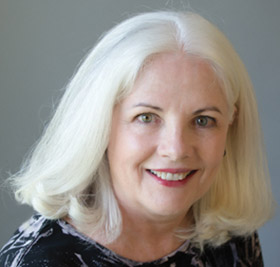 “It occurred to us that, unless we became vigilant, we were going to lose all the housing for the lower- and middle-income workers, like the vineyard, winery and hospitality workers who are integral to our economy,” says Mary Stephenson, a St. Helena marketing consultant who is also a founding board member and current board president.
“It occurred to us that, unless we became vigilant, we were going to lose all the housing for the lower- and middle-income workers, like the vineyard, winery and hospitality workers who are integral to our economy,” says Mary Stephenson, a St. Helena marketing consultant who is also a founding board member and current board president.
OTSH is now partnering with the USDA’s Rural Development, the nonprofit Rural Community Assistance Corporation (RCAC) and the city of St. Helena to build the McCorkle Mutual Self-Help Homeownership Development. When completed, the development is expected to have 18 affordable homes spread over two sites. The group received an assistance grant of $550,000 from the USDA last year, to be used toward the first stages of planning and outreach to potential homebuyers.
With the grant in hand, Stephenson says the city was willing to sell them an unused half acre of city land for one dollar, to be used for eight of the self-help housing units. The search is still on for a space for the remaining ten units. OTSH was expected to close on the purchase in March and to submit building plans to the city soon after.
Going forward, OTSH has applied for grants and loans from the county of Napa and RCAC, a nonprofit that contracts with the USDA to coach rural organizations through projects like these. Those loans are repaid through the homeowners’ monthly mortgages, which are issued by the USDA. Just as with the HFH and Burbank projects, homebuyers must meet a long list of financial qualifications, including the ability to pay a low-interest mortgage of what’s expected to be between $260,000 to $285,000. Homebuyers must also commit to spending 40 hours per week on building their homes.
As of the end of January, two community meetings had been held for potential homebuyers and 48 families have applied for the eight available units. According to Stephenson, the vast majority are Latino and all work in and around St. Helena. She’s hopeful that these first-time homeowners will breathe new life into St. Helena, with more parents to coach Little League and community volunteers to do all those things that make the town special. OTSH will continue to look for another site for the remaining 10 units of the housing project.
“The three things you need for successful affordable housing are political will, money and land,” says Stephenson. “We can get the money—this is a valley that’s very generous—and we’re working on the political will, but the land is very hard to come by.”
Building a community
Those working on the front lines of self-help housing have seen the positive effects that the program can have on both individual homeowners and the communities they create together.
“Many homeowners tell us they’re able to open their first retirement accounts, because they’re able to think differently about how to budget and save now that they’re not worried about their rent increasing,” says HFH’s Leja. “There’s a big sense of relief when they embark on homeownership with us, because it provides a stability that has often been lacking.”
Cornell agrees that, when the threat of rent hikes and uncertain housing is removed through home ownership, these families can finally breathe a sigh of relief. He also says that the homebuyers form a bond in building each other’s homes that makes the whole community a better place.
“A lot of people say, ‘Couldn’t you build it a lot faster?’” he says. “The answer is yes, we could, but most, if not all [participants] have never truly used a hammer before, and it’s also about a lot more than just building a housing project. We’re helping people learn to work together and, in the end, it produces a very stable neighborhood with less turnover than in other areas.”
For example, Stanley tells the story of one homeowner at the Woodland Hills project who’s way past his required 500 hours, but keeps showing up to work on his neighbors’ homes.
“That feeling of community will never go away,” she says.
Using Sweat Equity in Your Next Remodel
The term “sweat equity project” usually refers to self-help housing developments, but some contractors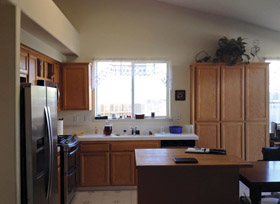 have latched onto the concept as a way to help clients save money on their remodeling projects.
have latched onto the concept as a way to help clients save money on their remodeling projects.
Valentino Construction of Fairfield is a family-owned business that’s been serving Napa, Solano and Yolo counties since 1991. Like many Bay Area contractors, it was busy working on high-end kitchen and bath remodels when the recent recession rolled in and the economy slowed. All of the sudden, banks weren’t making as many loans and people were hesitant to spend.
“My business plan took a U-turn and I reinvented myself,” says owner Peter Valentino. “I wanted to find a way to help people design their projects and do it more cost effectively.”
He turned to something he thought was a no-brainer: Offer to let customers take care of those jobs they felt comfortable doing on their own. Clients immediately seemed to buy into the concept as a straightforward way to trim costs without sacrificing on quality.
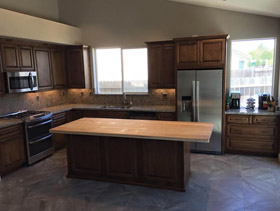 Valentino says that there are some jobs, such as plumbing and electrical work, that need to be left to the pros, but clients with some basic skills may be able to do the preliminary demolition work in a kitchen or paint a bathroom during the weekend while crews are off. One of Valentino’s clients recently asked if he could put down the flooring in a hallway, so his workers were able to complete everything but the floor and leave the homeowner with the materials and a few friendly tips. Because construction is such a schedule-oriented business, it’s important to have clear expectations and commitments from homeowners on what will be accomplished by a certain time.
Valentino says that there are some jobs, such as plumbing and electrical work, that need to be left to the pros, but clients with some basic skills may be able to do the preliminary demolition work in a kitchen or paint a bathroom during the weekend while crews are off. One of Valentino’s clients recently asked if he could put down the flooring in a hallway, so his workers were able to complete everything but the floor and leave the homeowner with the materials and a few friendly tips. Because construction is such a schedule-oriented business, it’s important to have clear expectations and commitments from homeowners on what will be accomplished by a certain time.
“It involves more project management skills to make sure we stick to the schedule, but it’s just like what I do with my subcontractors,” says Valentino. “We just layer the client into the schedule like any other team member.”
Valentino doesn’t think his company’s sweat equity option is the main reason people choose them, but he says it doesn’t hurt either. He notes that though they advertise the sweat equity option, plenty of people opt to have his team take care of everything.
“Some people love to be involved and some want to be as far from it as possible,” he laughs.
As far as the cost savings of bringing sweat equity to a project, it’s entirely dependent on how much you’re willing to do and what type of jobs you’re qualified to tackle. But as anyone who’s ever remodeled knows: Every little bit helps.
Contact Valentino Construction at (707) 425-1751 or www.valentinoconstruction.net.
Resources
Habitat for Humanity of Greater SF
(415) 625-1029
www.habitatgsf.org
Habitat for Humanity of Sonoma County
(707) 578-7707
www.habitatSoCo.org
ReStore
1201 Piner Road, Santa Rosa
707 568-3228
1411 Industrial Rd., San Carlos
(650) 847-4000
Burbank Housing
(707) 526-9782
www.burbankhousing.org
Our Town St. Helena
www.ourtownsthelena.org



